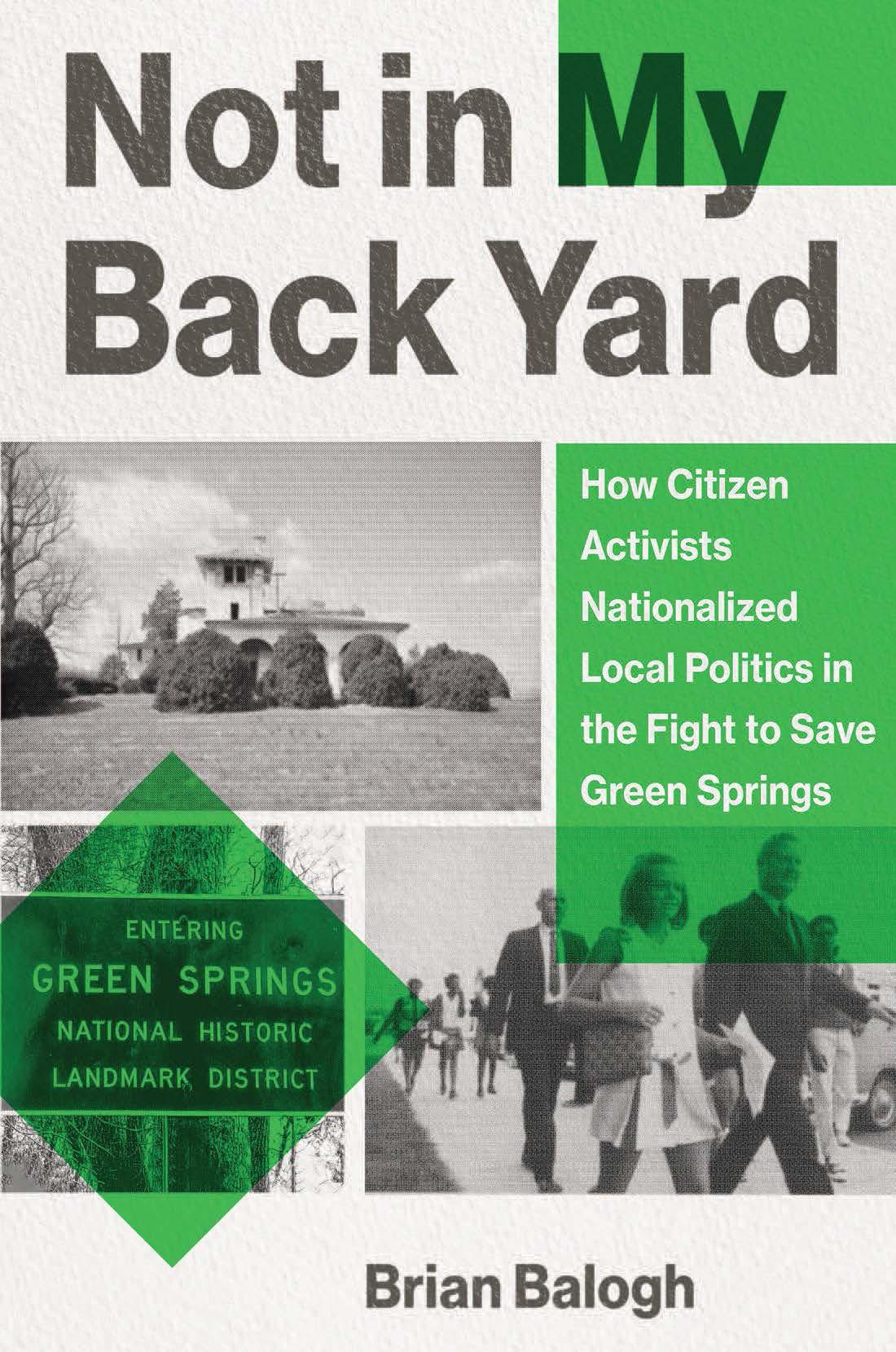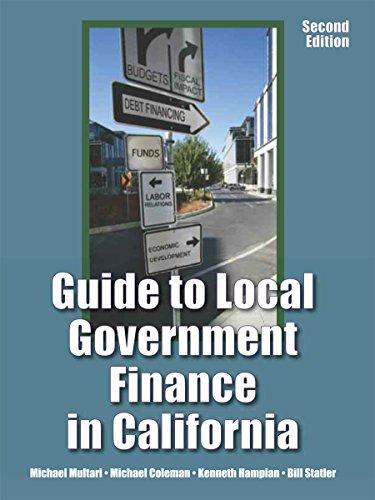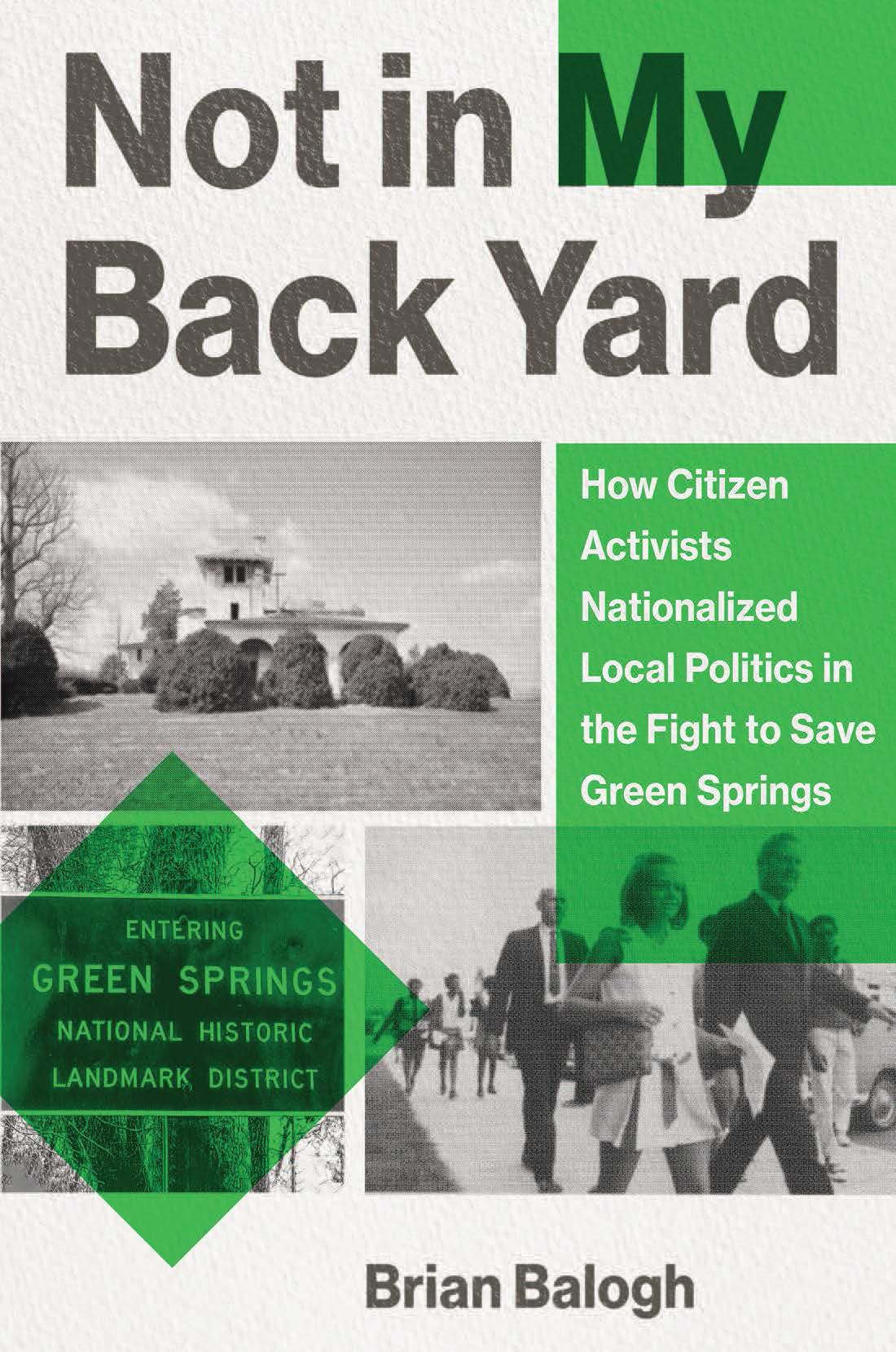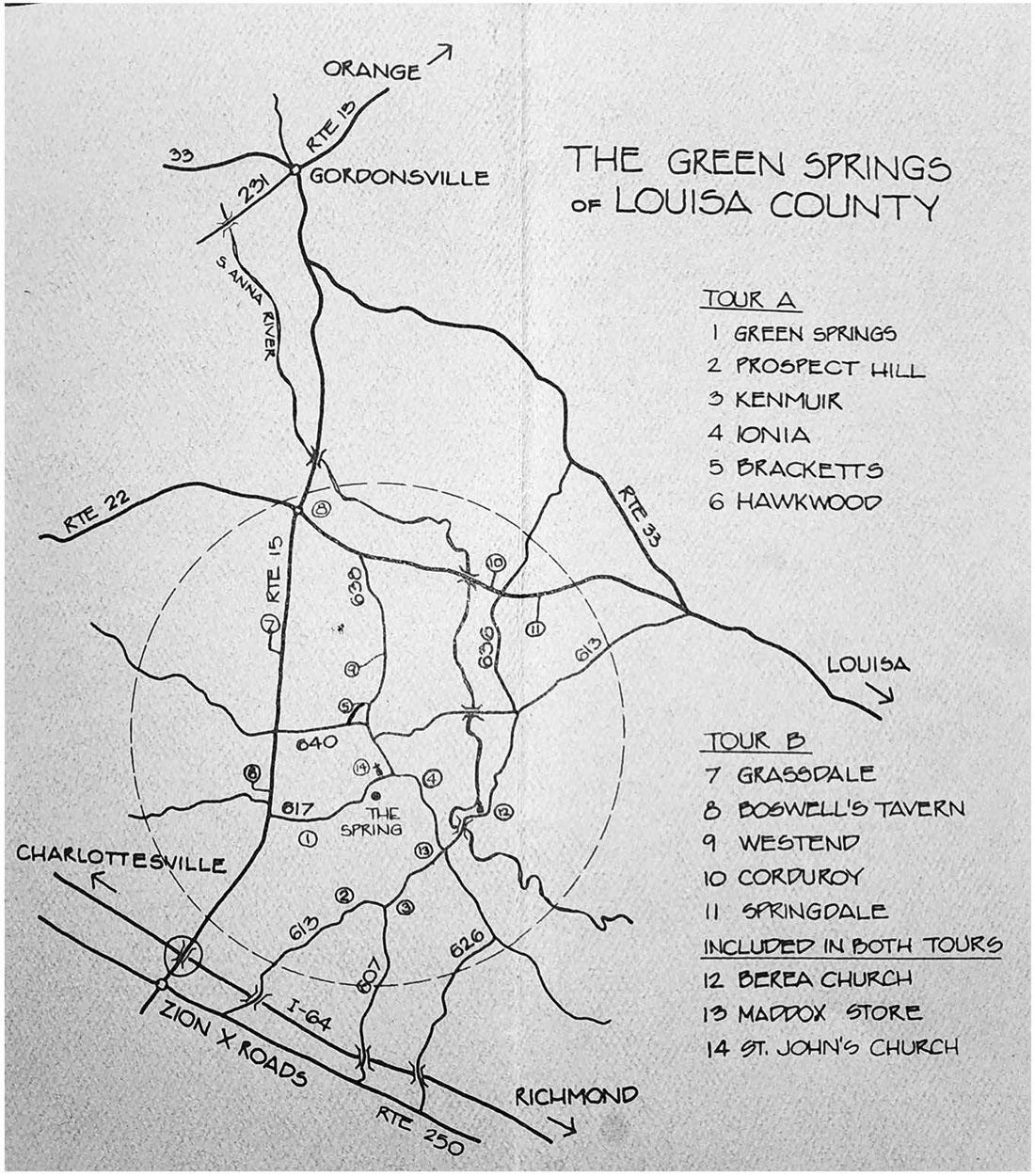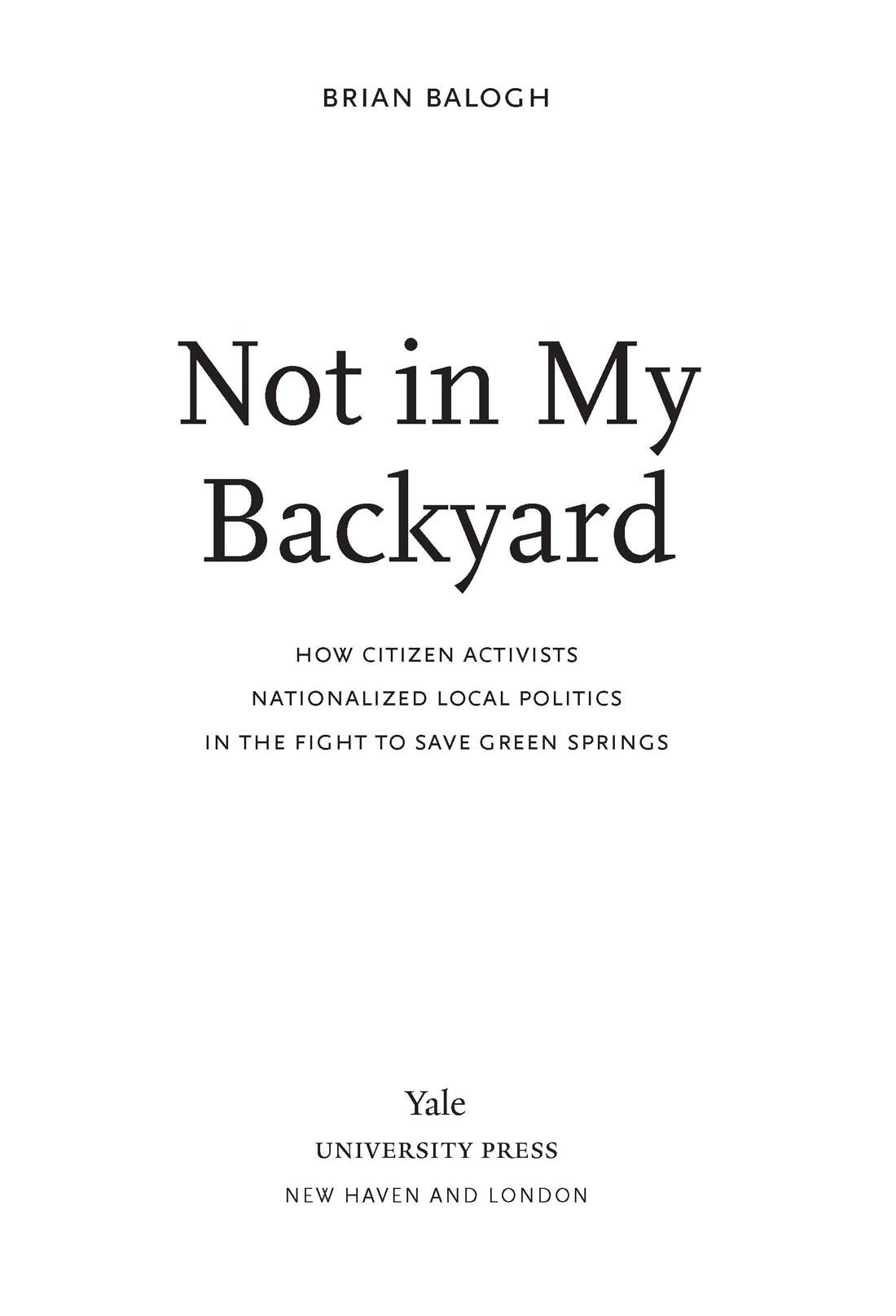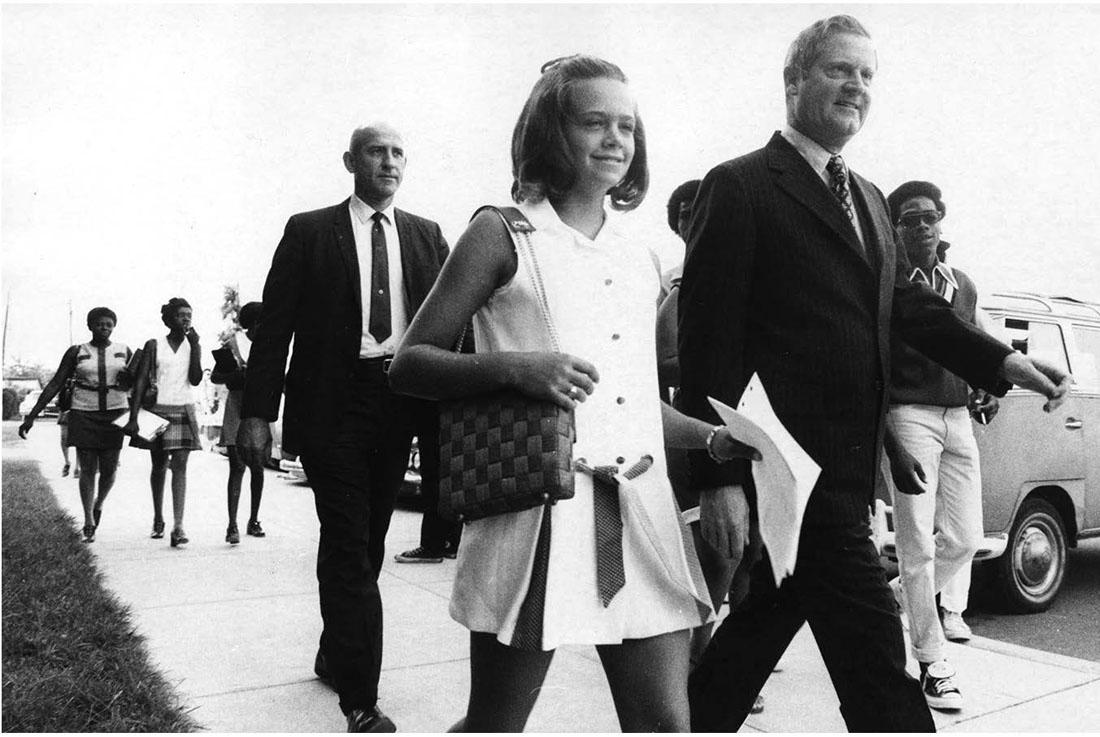NOT IN MY BACKYARD
Published with assistance from the foundation established in memory of Philip Hamilton McMillan of the Class of 1894, Yale College.
Copyright © 2024 by Brian Balogh. All rights reserved.
This book may not be reproduced, in whole or in part, including illustrations, in any form (beyond that copying permitted by Sections 107 and 108 of the U.S. Copyright Law and except by reviewers for the public press), without written permission from the publishers.
Yale University Press books may be purchased in quantity for educational, business, or promotional use. For information, please e-mail sales.press@yale.edu (U.S. office) or sales@yaleup.co.uk (U.K. office).
Set in Scala type by IDS Infotech, Ltd. Printed in the United States of America.
Frontispiece: Map from Green Springs house tours pamphlet, 1971. (The Green Springs Association)
Library of Congress Control Number: 2023936630
ISBN 978-0-300-25378-8 (hardcover : alk. paper)
A catalogue record for this book is available from the British Library.
This paper meets the requirements of ANSI/NISO Z39.48-1992 (Permanence of Paper).
10 9 8 7 6 5 4 3 2 1
Epilogue
Notes Acknowledgments
Index
ABBREVIATIONS
BOS Louisa County Board of Supervisors
DWI Virginia Department of Welfare and Institutions
EPA U.S. Environmental Protection Agency
FmHA Farmers Home Administration
HGSI Historic Green Springs, Inc.
JRWA James River Water Authority
LEAA Law Enforcement Assistance Administration
NEPA National Environmental Policy Act
NIMBY “not in my backyard”
NHPA National Historic Preservation Act
NPS National Park Service
SLAPP “Strategic Lawsuit Against Public Participation”
UVa University of Virginia
VHLC Virginia Historic Landmarks Commission
VRA Voting Rights Act
VVL Virginia Vermiculite, Ltd.
NOT IN MY BACKYARD
Introduction
“THE VERY FIRST THING I THOUGHT TO DO, and I told our board of directors instantly, we must all buy shares of stock. And they looked at me like I was crazy,” Rae Ely recalled. She bought a few shares thinking “those ten shares are going to carry me far, and they did.”1
Rae had never seen The Solid Gold Cadillac, Hollywood’s 1956 version of one woman taking on a giant corporation by purchasing a handful of shares, but twenty years after the Oscar-winning movie she turned a real-life W. R. Grace & Co. shareholders’ meeting to similar advantage, although it would take decades for the strategy to pay dividends. That Grace “was a corporation headed up by a man with a name—and it was an old family name, unlike ‘Mr. General Motors’ or ‘Mr. General Electric’ ” made it a “target.”2
By the May 1976 shareholders’ meeting in Boston Rae was on CEO Peter Grace’s radar. His staff warned that “Apparently, Mrs. Hiram (Rae) Ely . . . has gotten to the Secretary [of the Interior],” who had written a typical “eco-freak letter . . . asking us to give up our vermiculite reserves in Virginia.” There was every reason to expect fireworks at the meeting, and a cluster of Grace lawyers and security staff was dispatched to meet the anticipated band of angry women.3
Instead, they got what Rae described as a solitary slim and pretty southern gentlewoman “dressed like a fairy princess. I mean really eye-catching clothes, not conservative . . . because I knew I’d be on TV.” “Good morning gentlemen,” Rae drawled in her best Virginia lady accent. “So sorry about your lawyer.” “What?” one of
the men asked. As she headed for her seat Rae casually mentioned, “Well, you know he was arrested yesterday; I’m sure you’ll hear about it.”4
The lawyer, Bill Perkins, had diligently labored to clear Grace’s legal path to strip mine in the recently created Green Springs National Historic Landmark District. Perkins had been rounded up with ten other notables at a cockfight on Inglecress Farm near Charlottesville, home to the University of Virginia. The incident had been entertaining enough to elicit the New York Times’ headline “Uproar Over Cockfight Ruffles Virginia Gentry.” The top brass at Grace were embarrassed by the arrest; learning about it from Rae Ely only made matters worse.5
Rae had arrived at the shareholders’ meeting early to get a “really choice spot . . . in Peter Grace’s line of sight.” As soon as the public comment period began Rae jumped to her feet. “Well, Mrs. Ely,” Peter boomed, “so nice to see you here again this year.” “So nice to see you,” Rae replied with her big cheery smile, turning sideways so that the photographers and hundreds of shareholders could see her.6
“Mr. Grace,” Rae began, “I’m just here this morning to tell all these shareholders how grateful the people of Green Springs are to you, sir, for the efforts that this fine company is making to preserve the beautiful historic Green Springs valley in Virginia from efforts that this company had been considering making to extract vermiculite.” Rae knew that W. R. Grace still planned to mine in what she described as the most beautiful eighteenth-century grouping of historic buildings “nestled in the shadow of Monticello.” But she also knew that relationships mattered. That morning’s mission was to establish a good one with a powerful opponent.7
The tactic worked when the entire auditorium burst into applause; people stood and cheered. Peter Grace beamed. As shareholders boarded buses that whisked them to a bicentennial luncheon in Lexington, some men raced up to Rae and announced: “Mr. Grace would like to know if you would be kind enough to ride
with him today.” “Certainly,” Rae replied, “what a nice invitation.” She soon glided off in his limousine.8
“He’s just a jolly, hard-drinking, Catholic elf—raised by nuns,” Rae concluded. “This, of course, is the theme of the rest of our relationship. . . . You’re never going to persuade anybody by angry ranting.” Rae Ely’s vivid demonstration of the good will that the company could garner with shareholders by paying lip service to preserving history and the environment was just one gambit of many in her long-range strategy to drive the company out of the historic district that she had created.9
Years later, after moving to a farm in Green Springs, I began to hear what seemed like fantastical stories about Rae Ely. She had defeated Governor Linwood Holton’s effort to site a prison there in the early 1970s; she had prevailed over W. R. Grace’s attempt to mine; she had created America’s first national historic landmark in a rural district that encompassed thousands of acres; she had graduated from the University of Virginia School of Law without an undergraduate college degree; she had burned down her house in an attempt to murder her husband. Intrigued, I looked into these rumors, and much to my surprise, discovered that all but the last one proved to be true. I even noticed the bullet-pocked brown signs that announced the borders of that landmark district and realized for the first time that I lived inside it. Few people seemed to know much about Rae Ely’s life before she arrived in Green Springs in 1967. What I learned about her early years made her political success all the more remarkable.
Rae Hatfield was born in the Coconut Grove section of Miami on May 13, 1941. When Rae was five years old her mother was killed in a traffic accident. From that point on Rae was raised by a series of her father’s girlfriends and wives—three of them soon to be exwives. Her father, Ray Hatfield, captained yachts for unsavory characters, including, it was rumored, Al Capone. Hatfield only had an eighth-grade education, “but there was no smarter man that ever lived,” Rae recalled. “If he hadn’t been a drunk, he [would have]
done something with himself.” He could be a mean drunk—so much so that the state of Florida removed Rae from her home in the spring of 1954. She was placed in foster care and a few years later shipped to a high school for girls in distress in Thomasville, Georgia. When Rae turned eighteen she graduated (or aged out of) the Vashti Industrial School for Girls, took a job at a local business, and soon married her boss, Hugh Duncan. She did not stay in Thomasville or married to Duncan for long. In 1962, when she learned that Colonel Hiram Ely, the husband of a recently deceased prominent Dachshund breeder, was seeking an appropriate mate for his wife’s dogs, she showed up at his house in Flemington, New Jersey, with two candidates.10
Hiram’s 1692 gray stone manor house seemed magical. Likewise its dozens of acres, its horses, not to mention the fine Dachshunds and Colonel Ely himself. He was good-looking and accomplished; Rae was sold, despite the near-half-century age difference between them. They were married that same year, happily at first. Yet, as New York City’s exurban sprawl crept closer, the Elys sought safe harbor. In 1967 they moved to Louisa County, Virginia, a rural backwater whose seat a county supervisor described as “a one-horse town . . . and the horse died in 1936.”11
Although Rae knew nothing about politics—when they moved to Virginia she didn’t know if she and Hiram were Democrats or Republicans—her powerful will, capacity for learning, and knack for long-term strategy enabled her to shift from dependent to political action figure. She soon battled a series of powerful men who, in her opinion, threatened to destroy the unique rural character of her neighborhood and her rights as a fully empowered citizen. Her first antagonist was, at the time, Virginia’s first Republican governor in the past century, Linwood Holton. In May 1970 he announced plans to close Richmond’s decrepit state penitentiary by building a new “diagnostic center” to sort and rehabilitate convicted felons. It would be located directly across from the Elys’ front yard in Green Springs. An island of wealth in otherwise impoverished Louisa County, Green
Springs, with its many surviving plantations, had begun to attract northerners like Rae and Hiram fleeing exurban sprawl.
The fight against the prison was so prolonged that the Washington Post labeled it “Holton’s Vietnam.” Rae next took on multinational mining conglomerate W. R. Grace & Co., which wanted to mine Green Springs’ vermiculite, a rare absorbent mineral used in construction, manufacturing, potting soil, and sometimes as cat litter. The neighborhood activists eventually defeated Grace in a battle that lasted even longer than the prison fight.12
Along the way, Rae Ely and her allies established the first national historic landmark to be honored explicitly for preserving the heritage of thousands of acres of rural history, joining a small group of American landmarked icons including the Alamo and Mount Vernon. The Green Springs National Historic Landmark District was created when property owners placed scenic conservation easements on thousands of acres of private land, sacrificing their right to subdivide their property or interfere with the rural environment that surrounded the houses and other structures. Creating a landmark to preserve rural history was all the more remarkable because nobody in Louisa’s political establishment believed that Green Springs had any notable history. As the district’s own supervisor told Time magazine, “Virginia is full of old houses like that.”13
The citizens’ group led by Rae challenged the local branch of an old political machine, Virginia’s Byrd organization. Circuit court judges ran the organization in rural counties, and in Louisa that judge was Harold Purcell. The local courthouse crowd had been coerced by Federal courts to integrate the Louisa County High School in 1970, but the all-white male group of public officials remained in firm control of other local prerogatives like land use. The majority of the county’s voters vigorously supported the courthouse crowd’s agenda: protecting male and racial privilege as well as property rights, prioritizing economic development, and most vocally, keeping the Federal government out of the county’s business—at least
business that was not profitable for political insiders or that might bring jobs.14
Green Springs’ middle-class white women may have leaned heavily on history to preserve the rural quality of their property, but they bridled at the Byrd organization’s historically insulated style of politics. Instead, they engaged the full range of political venues directly (rather than merely at the ballot box or through their elected representatives), from mass meetings, to petitioning, to lobbying distant Federal agencies and litigating in Federal courts. By 1980, local land-use policy in Green Springs—a government prerogative kept as close to home as Jim Crow segregation had been—was shared with the “Feds” and a nonprofit organization led by Rae Ely and powered by female citizen activists.
How did Rae Ely beat the odds and defeat the local machine, a powerful governor, and a Fortune 500 company? Some of the answers were obvious: her talent, skill, and persistence. It helped that she was white and upper middle-class. As I dug deeper into the extensive documentary evidence and began to interview locals, many of whom were afraid to talk about the courthouse crowd fifty years later, I realized that the full answer required an appreciation for the historical context in which this story unfolded. Rae was successful because the political, social, and economic landscape was shifting rapidly when she jumped into politics in 1970. Her personal story wound through some of the key changes experienced by Americans in the last third of the twentieth century. Indeed, it illuminated them. Rae conquered that shifting landscape and leveraged the new resources for citizen activists it unearthed. She was the right woman in the right place at the right time.
Her story provides a unique perspective on American politics in the last third of the twentieth century. The most important change she turned to her advantage was the rising demand—especially among progressives—for an improved quality of life, manifested most visibly in the surging environmental movement. So too her recognition that the national government had penetrated a
centuries-old local monopoly on racial matters by 1970. Why not engage the Federal government to protect the quality of life that she and her neighbors enjoyed in Green Springs?
That such a quest was endorsed far more heartily by national elites both in the environmental protection sphere and among historical preservationists only increased the incentive to circumvent local control. The Green Springs activists harnessed legislation like the National Environmental Policy Act (NEPA) of 1970, Federal agencies like the Department of the Interior, and the Federal judiciary to override local majorities who resented both the Feds’ intervention in their business and any restrictions on their property. Although the white female activists in Green Springs had never been denied the right to vote, their voices had been silenced by the same ruling oligarchy that until recently had presided over Jim Crow segregation.
Gaining access to national venues had never been easier given a decade-long commitment to opening national administrative agencies, regulatory review, and most importantly, Federal courts to citizen comments, concerns, and legal standing. Rae plunged into politics at a moment in American history when autonomous rightsbearing individuals increasingly displaced place-based communities, as did groups who identified by race and gender, regardless of where their members happened to live. In an age of jet travel, interstate highways, national broadcast networks, and most significantly, the demise of legally enforced Jim Crow segregation in the South, the connection between place and political jurisdiction meant far less than it had even a decade earlier. By 1975, the most visible pillars of the Jim Crow regime had been dismantled, clearing a path for citizens with far different backgrounds and agendas than civil rights activists. These newly minted activists demanded that theirnational constitutional rights be protected as well, even when local oligarchies like the one that governed Louisa County insisted otherwise.15
Although place as political jurisdiction meant less than it had a few years earlier, many middle-class white women were introduced
to politics when something both dear and near to home was threatened. Rae was only one of hundreds of thousands, perhaps millions, of citizens who engaged directly in political action for the first time in the 1970s. Although they adapted strategies and tactics forged by the national civil rights, anti–Vietnam War, environmental, and second-wave feminist movements, these activists advanced far different agendas over the next three decades than the social movements of the sixties. Much of this activity occurred at the local, often neighborhood level. Newly engaged citizens reconciled the demise of place-based governance with the rise of neighborhoodbased agendas by identifying more closely with likeminded Americans thousands of miles away than with certain neighbors just down the road.
Governor Holton announced his plans for the diagnostic center shortly before the NewYorkTimesquoted highway and public utility officials criticizing “backyard obstructionists.” The phrase slowly morphed into “not in my backyard” (NIMBY). Those advocating for new construction or changes in land use usually applied the term to somebody else’s backyard—protesters who opposed a range of initiatives, from mobile home courts to the transportation of nuclear waste; from shelters for the homeless to drug treatment centers. It was just this kind of intrusion that prompted Rae Ely’s initial foray into politics. What critics of NIMBYs have missed because their causes are so often neighborhood-based are the common concerns that many NIMBYs share across geographic boundaries. Those shared concerns about quality of life issues reshaped national political agendas.16
Perhaps the most surprising resource seized by Green Springs’ citizen activists was triggered by changing conceptions of what constituted history. It was only after a Ph.D. student at the University of Virginia introduced a newly minted framework for understanding Green Springs’ past that residents embraced it as the best way to authenticate the area’s distinctive characteristics. Prison opponents argued that history consisted of more than famous political leaders and military battles. An approach that captured the
relationship between old structures—even if nobody famous ever slept there—and the surrounding landscape encouraged Green Springs residents to dig deeper into their own past. It ultimately shaped the district’s future.
By the 1970s these tectonic shifts in the relationship between citizen and state were taking place against a backdrop of long-term economic decline in the United States. Yet policymakers continued to promise more, especially when it came to issues like the environment. Doing more with less money is precisely what the Green Springs activists promised to achieve through the publicprivate partnership they crafted. Private easements would now protect 14,000 acres from intrusions like prisons and strip mining. To be sure, the Federal government played an important role. But the Feds were joined by those private landowners who voluntarily restricted the use of their land, and by Historic Green Springs, Inc., which connected landowners to the National Park Service (NPS).
The urge to do more with less explains, in part, the fluid state of partisan politics during the 1970s. By 1975, fiscally constrained Federal administrators no longer contemplated massive projects like the national parks built during the New Deal. Both liberals and conservatives, Democrats and Republicans, emerged from this era with a renewed commitment to public-private partnerships. This was hardly the triumph of the free market so often associated with the “Reagan Era,” but it did accommodate growing voter frustration about rising taxes, budget deficits, and centralized control.
Nor did political parties demand the kind of strict partisan allegiance that paralyzed politics by the twenty-first century. Rae Ely was backed by Republican secretaries of the Interior under Presidents Richard Nixon and Gerald Ford, even though that support pitted them against Virginia’s Republican governor. It could not have been comfortable for Interior Secretary Rogers Morton, a former Republican National Committee chair, to back Linwood Holton’s Green Springs opponents. Nor was it easy for President Ford’s secretary of the Interior to publicly pressure a major Republican donor like Peter Grace to forgo mining.
Republicans and Democrats had already begun to diverge in 1970 over local control, especially when it came to integrating public schools. President Nixon’s signature domestic program, the “New Federalism,” promised to reverse the flow of power to Washington. In an extraordinary jujitsu move, Ely used the Federal legislation that funded Holton’s proposed prison, support that was explicitly designed to cutFederal strings, to circumvent local courts. The result was a landmark decision in the United States Court of Appeals for the Fourth Circuit that imposed a virtual spider’s web of restrictions on how Virginia could use those Federal funds, ruling that other national legislation passed to protect the environment and preserve the nation’s history trumped Nixon’s pledge to return decisions to “local officials responding to local conditions and local constituencies.”17
Nixon appealed to the growing number of Americans who insisted that improving the quality of life for middle-class citizens directly threatened their own economic progress. Louisa County’s citizens battled over two contrasting visions of progress. Pushing back against the Green Springs crowd, most Louisans, whatever their attitude about prison reform, recognized an opportunity for job creation when they saw one. Every public official in Louisa County agreed and supported both the prison and mining.
What began as Nixon’s tentative effort to reverse the powerful trend toward nationalizing politics fanned broad rural support for a set of ideals that had long defined the courthouse crowd’s agenda. When I started my research in 2010, I viewed many of the arguments mounted by Louisa’s ruling oligarchy about race, the sanctity of private property, and the evils of centralized government as the last gasp of a part of America that was vanishing. Rather, these beliefs soon became (many would argue had already become) the foundation for one of the two major political parties in the United States, along with the rural base of voters that supported these appeals.
One relentless, talented person can make a big political difference when history, strategy, and determination are on her side. Rae Ely faced long odds when Louisa’s governing establishment supported Governor Holton and W. R. Grace. Their collective appeal to the residents of this impoverished county was jobs. Ely prevailed because she tapped a new style of participatory politics first crafted by the civil rights movement. She tethered direct citizen engagement to the expertise and regulatory authority of the National Park Service and Department of the Interior. She circumvented local courts, going directly to the Federal judiciary. In redirecting the national government’s resources toward preserving history and the environment, she challenged long-standing commitments to government-stimulated economic growth at any cost.
What began as a personal quest evolved to break a political machine’s stranglehold; carve out a space for legitimate debate about ill-conceived plans; and ensure the proper balance between economic growth and concern for the environment as well as cultural resources. Ely’s lessons and strategies now resonate across the country and political spectrum in ways she trailblazed but might not have intended. That is because she created the template today deployed by thousands of neighborhood groups who resist any form of development—thwarting, for instance, initiatives to make housing more affordable.
By the twenty-first century it was easy to poke fun at NIMBYs, as suggested by the growing list of more caustic acronyms such as BANANA (build absolutely nothing anywhere near anything) and NOPE (not on planet earth). Virginia’s current governor, a dark horse for the Republican presidential nomination, has been tagged YIMBY (yes in my backyard) in Chief. However, the half-century-long Green Springs battle is a reminder that self-interested motives do not preclude public benefits. Women who had never engaged politically mobilized effectively to fight the courthouse crowd, Governor Holton, and W. R. Grace. Increased political engagement, whatever its motivation, surely counts as a civic gift. So too the tangible
alternatives to government or corporate insistence that is “my way or the highway.”18
Protecting their own property was hardly the only motivation for the citizens who worked with Rae Ely in Green Springs. They also wanted to preserve what they believed was a national treasure. For some, this was merely the beginning of their political engagement. Because they got involved, residents discovered a history that they had not previously been aware of. Creating and preserving that history enhanced the nation’s backyard by protecting a slice of rural history that grows more valuable with the construction of each new Starbucks, especially the one just a few miles down the road from historic Green Springs.
A Reform-Minded Republican
LYNDON JOHNSON’S LANDSLIDE 1964 victory over his Republican challenger for the presidency, Barry Goldwater, promised to cement a Democratic majority in Congress well into the future. Yet the five states that Goldwater carried outside of his home state of Arizona, in the so-called Solid South, demonstrated the fragility of the Democratic Party’s century-long hold on that region. Goldwater’s national humiliation juxtaposed against his southern triumph ignited a fierce battle within the Republican Party. Some rising stars, like Ronald Reagan, picked up where Goldwater’s state’s rights rhetoric left off, while others, like New York governor Nelson Rockefeller and Michigan governor George Romney, aimed for moderate Republicans and independents. In 1968, Richard Nixon sought to blend both— pursuing a moderately progressive domestic policy agenda while dog-whistling to white southern voters on issues like local opposition to busing and the surging national concerns about crime. His strategy underscored just how ideologically malleable the GOP had become for the moment.
In 1969 Linwood Holton capitalized on Nixon’s appeal to moderates when he ran to the left of his Democratic opponent in the race for governor of Virginia. The link between party and ideology, tenuous at best between 1945 and 1968, continued to unravel with Holton’s victory. There was every reason for the new governor to believe that reforming the Commonwealth’s antiquated prison system might appeal to the coalition that had just elected him.
“Border state” Virginia had not gone for Goldwater, but Nixon’s success in appropriating the crime issue from southern Democrat George Wallace in 1968 left little doubt about its salience a year later. Doing something about crime was at the top of the incoming governor’s agenda. Holton’s approach to crime, however, embraced a long-standing progressive framework for reducing it: rehabilitation. His crime policies resembled the New Deal and Great Society approach far more than the “tough on crime” and “lock them up” approach that both national political parties would soon embrace to build what scholars call the carceral state.
Holton had not devoted much attention to the other domestic policy that had captured the nation’s attention by 1969: protecting the environment. A note from his good friend and political ally, Republican Delegate Ray L. Garland, focused the governor’s mind. Garland wrote to “Lin” suggesting two seemingly disparate issues that were political sure bets. “If your Administration would take a strong and effective stand against our increasing crime rate and the deterioration of our environment the people of Virginia would overflow with gratitude.” Holton did just that, but in Louisa County a few residents who cared about the environment overflowed with rage, not gratitude. They entangled his crime policy with their quest to preserve the natural and cultural environment and plunged Holton into a controversy that outlasted his four years as governor.1
Abner Linwood Holton, Jr., was born in 1923 in the Appalachian village of Big Stone Gap, Virginia, whose 3,000 residents lived tucked into a gorge between mountains in the heart of coal country. Linwood’s father’s management position for the Interstate Railroad company placed the family squarely in the middle class, but the future governor must have observed plenty of rural poverty despite his own comfortable childhood.2
Holton claimed that he couldn’t remember a time in his life when becoming governor of Virginia “wasn’t simmering in the back of my mind.” Republican loyalty made sense for a boy from western Virginia, where that party had deep roots, but it was one of the few
places in the Commonwealth where it did. When he was courting Jinks Rogers, “the love of his life,” she was embarrassed to be seen with a Republican and refused to ride on Dwight D. Eisenhower’s campaign train as it rolled through Virginia in 1952. Resilient, persistent, or simply stubborn—all three adjectives applied to Linwood Holton—he convinced Jinks to marry him in 1953.3
Ike’s victory in Virginia buoyed Holton’s hopes for a Republican Virginia. When he ran for the House of Delegates in 1955 and 1957, losing both times, his party’s platform embraced gradual school desegregation. Though barely moderate, it stood in stark contrast to the Democrats’ “massive resistance” to integrating public schools. Holton continued party-building and in 1965 accepted the dubious reward of the Republican nomination for governor in the wake of President Lyndon Johnson’s landslide victory. Linwood well understood that he had little chance of defeating his Democratic opponent, Lieutenant Governor Mills Godwin. Once again that combination of resilience, persistence, and stubbornness drove him toward a seemingly impossible dream.4
A shrewd strategy helped Holton realize it. He hoped to augment a Republican minority with the burgeoning African American vote, topping it off with a growing number of white Democrats disaffected by their party’s staunchly segregationist stance. Holton was rewarded with enough of the vote—38 percent—to run again in 1969. This time the divisions within Virginia’s Democratic Party and Holton’s endorsement from President Richard Nixon put the Republican over the top with 53 percent of the vote.5
The first Republican elected governor since 1874, Holton would soon claim another first for his family. Doubling down on his inaugural claim that “the era of defiance is behind us,” Holton became the first governor of a southern state to send his children to an integrated public school, a moment so extraordinary that the New York Times memorialized it in a front-page photo (Fig. 1). Slim and erect, thin-lipped smile firmly in place, Governor Holton strode beside thirteen-year-old Tayloe as she entered the previously all–African American Kennedy High School. “It’s always hard for a child
to change schools,” the governor said. “They don’t want to leave old friends. But my children go where they are assigned.”6
Figure 1. Governor Linwood Holton walks his daughter Tayloe to a recently integrated public school, September 1971. (Librado Romero/The New York Times/Redux)
Holton’s victory may have been anomalous, but it epitomized a remarkably fluid period in American partisan politics. Just a year earlier, segregationist Democratic Alabama governor George Wallace ran as an independent, carrying five states in the deep South and lengthening the odds for Democratic presidential nominee Hubert Humphrey. The solid Democratic South no longer looked quite so formidable. Holton joined a host of moderate Republicans in the GOP, headlined by the “New Nixon.” The former Cold Warrior was eager to demonstrate that he could work with an increasingly progressive-leaning Democratic Congress. Especially compared to the intense partisanship that characterizes twenty-first-century
national politics, party loyalty was tepid at best in 1969, with the ideological tilt of each party often difficult to discern.
Governor-elect Holton quickly acted on both of Garland’s suggestions, first previewing a prison reform plan, and soon after, capitalizing on the growing popularity of the environmental movement by creating the Governor’s Council on the Environment. Indeed, Holton was naturally drawn to the conservation issue by virtue of a happy childhood spent swimming in the rivers and fishing in the mountain streams of Big Stone Gap. Although chief of staff John Ritchie had to twist his arm to get him to attend the first Earth Day in 1970, an event that was to engage more Americans than the biggest civil rights or antiwar demonstrations of the 1960s, Holton later conceded that attending Virginia’s celebration had “turned out to [be] a very good move.”7
Addressing crime and the environment appealed to Holton because they both had limitless “upside,” with little risk for controversy. After all, avoiding controversy had been one of his campaign’s hallmarks. “I just said, ‘Look, you need to have [the] competitive force of two parties. It’s a two-drugstore town.’ ” Unfortunately for Holton, his signature crime initiative would soon undermine his reputation as a friend of the environment.8
Americans listed crime in 1968 as their top domestic concern for the first time since Gallup began asking that question in the 1930s. In the South, and in some urban areas racked by several years of urban rebellions, attitudes had hardened and calls for “law and order,” egged on by George Wallace, Ronald Reagan, and Vice President Spiro Agnew, were on the rise. Progressives, however, among them recently retired Supreme Court Chief Justice Earl Warren (a former Republican governor of California), still controlled the incarceration agenda. They believed that prisons should reform rather than punish. Holton opted to address crime in a manner that had the hallmarks of liberal penal reform.9
Governor Holton’s approach had something for every segment of his diverse constituency. Felons got jail time. Yet Holton blamed poverty and psychological factors for crime—conditions that could be
remedied. In the long run, remediation would make Virginians safer, provide an economic stimulus to host communities, and ultimately shrink the size of government by properly diagnosing felons— returning them to society as productive tax-paying citizens.
Whatever Holton’s approach, no governor could ignore the festering situation at the state penitentiary. Opened in 1800 on the outskirts of Richmond, by 1970 the “Pen” stood near the center of town, a block or two from the Governor’s Mansion, where the Holtons had ample opportunities to see, smell, and hear what went on there. The gigantic complex with its stacked rows of windowless cells fronted by barred doors, combined with its dungeonlike basement for the “worst of the worst,” was “hardly a place to send a man and expect him to return to society having learned he must behave or be confined,” as one reformer put it.10
Holton’s first step, and the centerpiece in dismantling the penal dinosaur, was a proposed state-of-the-art “reception and diagnostic center.” Initially estimated to cost roughly $3.7 million, the diagnostic center would be the “first stage in the development of an entirely new approach to dealing with the convicted offender in Virginia.” It was backed by expert research on crime that recommended smaller specialized units and proper classification as the way to reduce recidivism. Local news media embraced the approach: “The sooner Virginia can restore the criminally convicted to society equipped for something better than continuation of a life of crime, the better off Virginia will be.”11
Holton’s point man on prison reform was Otis L. Brown, just a round-faced thirty-two, and looking even younger, when Holton’s predecessor, Mills Godwin, appointed him director of the Department of Welfare and Institutions (DWI). Brown was part of the “can-do” generation infused with President John F. Kennedy’s “Camelot” spirit whose grail was to improve the lives of citizens through government action. He seemed the perfect pick for the job of ensuring that prisoners were properly classified and assigned the correct treatment plan. All adult male felons in the state would “undergo sophisticated classification processing in a system that utilizes every pertinent
discipline, functioning among pleasant surroundings calculated not to dehumanize the offender.” Holton and Brown planned to apply space-age tools to an age-old problem and tackle the nation’s number one domestic concern in a fashion likely to appeal to a broad cross-section of voters.12
Brown had served in state and local government long enough to understand that nobody wanted a prison close to their home and that siting the diagnostic center might get tricky. When he chose a Louisa County location fifty miles west of Richmond, he must have been aware of the fuss a few Louisans had raised when the Virginia Electric and Power Company (VEPCO) announced in April 1968 that it planned to build a nuclear reactor near there. That this momentary kerfuffle ultimately failed to stop VEPCO’s plans must have reassured Brown: compared to the intense, prolonged citizen opposition to reactor siting in California and New York State—protests that thwarted both projects—the nuclear issue was less contentious in Louisa County. The county needed the tax revenue, the construction jobs, and the roughly one hundred permanent jobs that the utility promised. The reactor cooling pond, soon christened “Lake Anna,” created valuable waterfront property overnight and, as the Central Virginiangushed, “perhaps one day, even a destination resort.”13
Reassuringly, Brown and Holton could count on Louisa’s political leadership. Little had changed over the last half-century in the way citizens expressed their political preferences. The hierarchy established by Senator Harry F. Byrd, Sr.’s political organization was designed to dampen voting and quash citizen engagement. It left local decisions in the hands of circuit court judges like Louisa County’s Harold Purcell. Although this was a Democratic machine, even a reform-minded Republican governor could count on Louisa’s courthouse crowd to take care of business if that meant jobs for the county. There is no record of discussions with the man who sat atop the local power structure, but Brown and Holton had good reason to assume that the judge would like the 200-acre site selected for the diagnostic center. The Commonwealth planned to purchase it from
